Welcome to The American Downtown Revitalization Review -The ADRR
2024
VOLUME 5
Article
A SUCCCESS STORY IN DALLAS
January 1, 2024
By Andrew M. Manshel, author of Learning From Bryant Park
Editor’s Note. An earlier version of this article appeared in Andy’s The Place Master blog.
Clyde Warren Park in Dallas works. A recent visit, more than ten years after its opening, showed it to be heavily used and reasonably well managed. On a weekday afternoon the park had quite a few visitors, including lots of children.
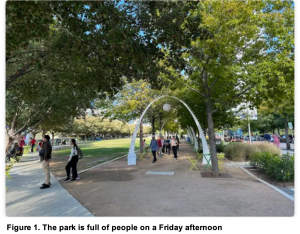
The park has most of the elements that make public spaces successful:
- Shade – essential in the southwest
- The one here is very cleverly designed and attractive – including fun water features
- Lawns
- Food kiosks and restaurants
- Water features
- Regular programming
- Movable chairs
- Adequate maintenance
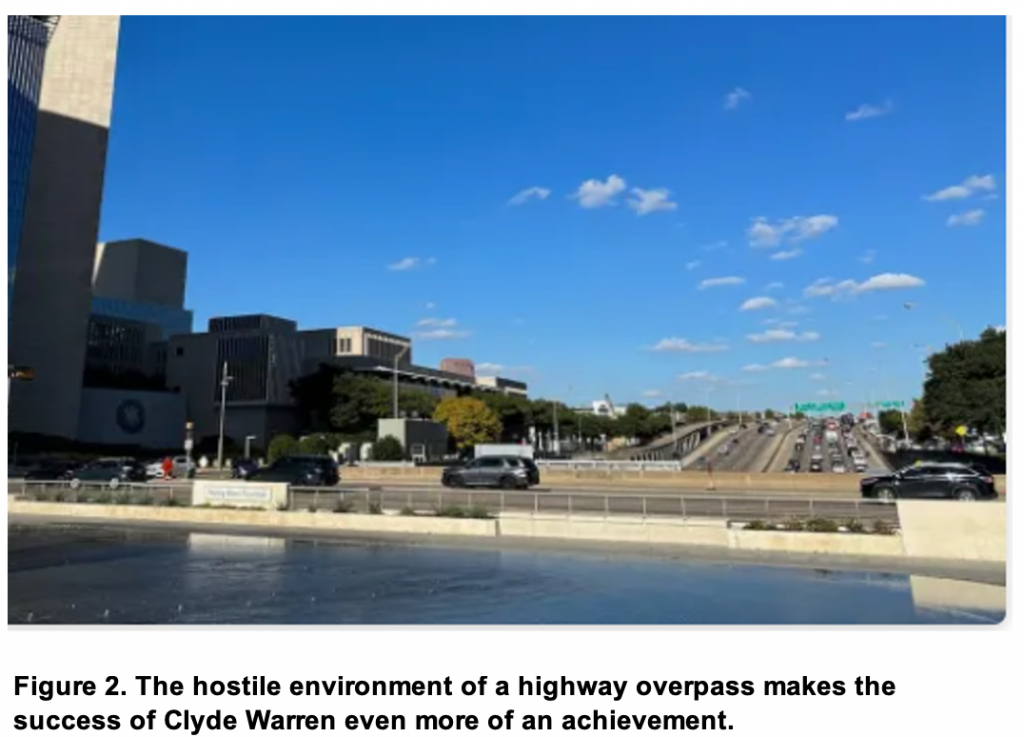
As we have written ad nauseum, there are so many new public space projects, and so few of them are successful. Clyde Warren was built over a highway culvert – a category of assignment that has proved particularly challenging for public space planners over the last couple of decades. Building over a highway cut can be an essential move in re-knitting a downtown together. But doing it right is a tough assignment. The designers of Clyde Warren, The Office of James Burnett, got what animates a public space on a deep level that seems to elude almost all landscape architects and public officials. After ten years, Clyde Warren is still performing well – attracting a broad swath of users. On the day we visited a large portion of the park was closed for a private event – but there was still quite a bit of space available to the casual visitor.
A good contrast with Clyde Warren is another public space in the southwest, Santa Fe’s Railyard Park of about the same vintage – which remains virtually unused, despite quite a bit of interesting development around it. The arts district of downtown Dallas is not the most promising or hospitable of environments for a public space. Downtown Fort Worth is way more walkable, human scaled and attractive. The surrounding streetscape to Clyde Warren is towers and institutions set back from the street – essentially bleak, unwalkable and car oriented. Prominent among the high design structures of the arts district (Rem Koolhaas, Norman Foster) are a large number of parking structures. But somehow, pedestrians find their way to the two large blocks that constitute Clyde Warren — most likely from the offices and residential towers that overlook the park.
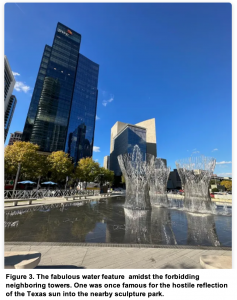
The nonprofit that operates the park, The Woodall Rodgers Park Foundation, has an operating budget of around $15 million. The biggest challenge for public spaces with water features is keeping them running. And the features at Clyde Warren are complicated and fun to watch. The Foundation seems to have the resources to keep things running. The water features are open for kids (and adults) to splash around in – which is just great, and unfortunately not standard practice. These water features are complex and they work. Kudos to the park’s managers.
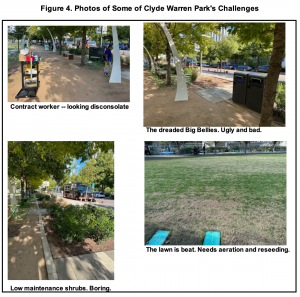
That not-withstanding, the Foundation appears to contract out for the park’s maintenance, and it shows. Outsourced maintenance is never as detailed oriented and perfectionist or as highly motivated, well-compensated internally managed staff. The park demonstrates a lot of wear from high use and is not kept to the high standards of Bryant Park. The lawn panels need aeration and reseeding. The horticultural elements are designed for low maintenance and aren’t well maintained even given that. They don’t have the kind of visual pop that a public space of this caliber really ought to have. Some of the arts institution facilities in the district have much more imaginative and appealing plantings nearby
Big Belly trash receptacles are in use – which are a bête noire of mine. They are a mark of managerial laziness. The design is awful – they are a squat box. The labor they supposedly save, is labor that the park really needs. Staff dumping out the trash bins are a visible mark of social order. Visitors want to see people working in the park – maintaining the horticultural elements and emptying the trash bins. It contributes to the perception of public safety.
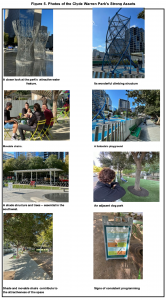
But, as can be seen in Figure 5, those issues aside, Clyde Warren Park, is a clear model for others to follow as to what makes a park lively and attractive. The built environment in downtown Dallas makes creating lively public spaces a challenging task, and so the park’s success is even more a particular achievement.
A pdf version of this article can be downloaded HERE
